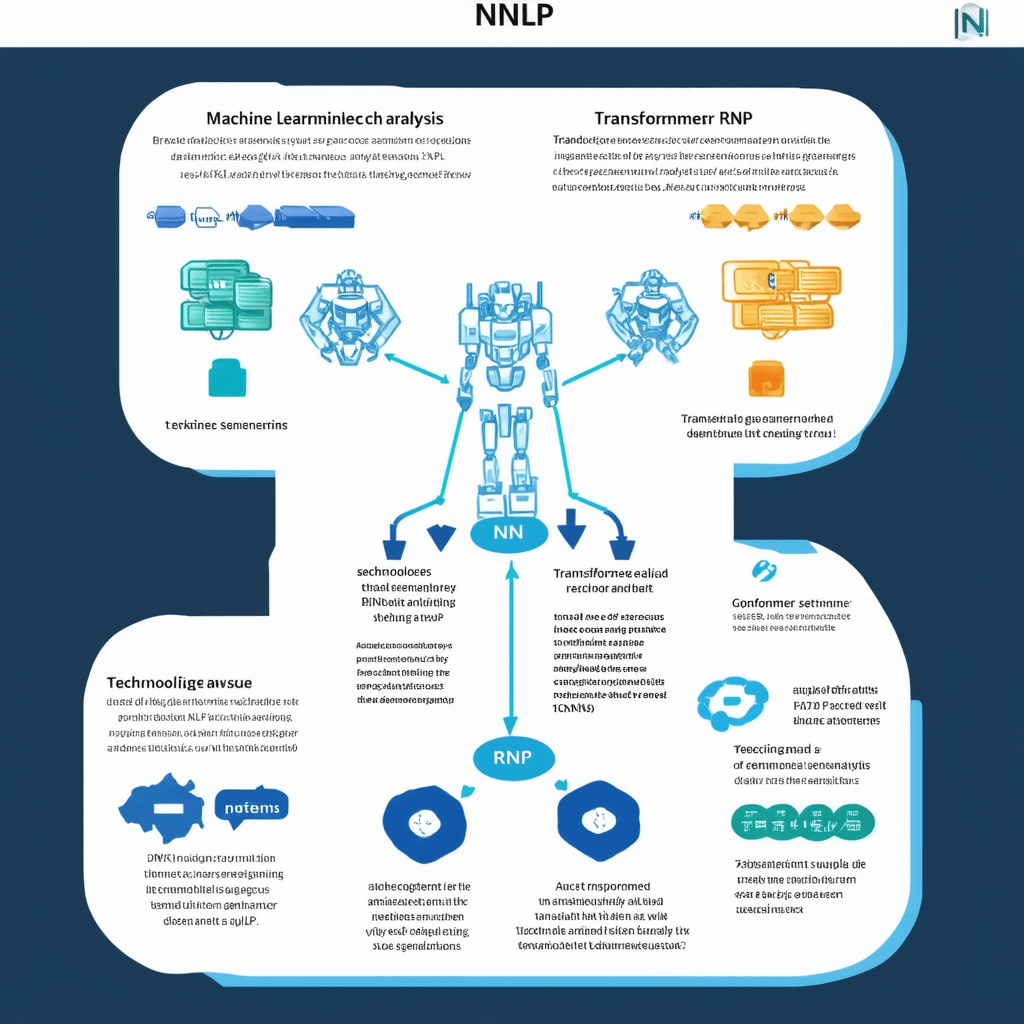Introduction: A Deep Dive into Natural Language Processing
Table of Contents
Imagine waking up to a world where your computer truly gets you. Not just turning on with a button press, but understanding your groggy morning request to brew a cup of coffee. Natural Language Processing, or NLP, is steadily making this a reality. It’s about computers interpreting the nuances of human language. Now, think about your smartphone. It doesn’t just recognize your voice; it gets the sarcasm in your joke or the urgency in your request. This is the subtle brilliance of NLP at work.
Consider virtual assistants like Alexa or Google Assistant. These aren’t just fancy gadgets; they’re evolving companions that can schedule your appointments or remind you of your best friend’s birthday. It’s not magic; it’s the intricate algorithms of NLP that make these interactions feel almost human. Chatbots, too, are becoming more sophisticated. They’re not just there to answer basic customer service queries anymore. With NLP, they can handle complex questions and provide nuanced responses, making customer support faster and more personal.
In real-world applications, companies like OpenAI and IBM Watson are pushing the boundaries of what NLP can do. From translating languages in real time to analyzing sentiment in social media posts, NLP is reshaping industries. It’s not just about making life easier; it’s about bridging the gap between human intuition and machine logic. The key takeaway here is that NLP doesn’t just transform our interactions with technology—it transforms technology itself, making it a seamless part of our daily lives. (Read our full guide on Machine Learning and Data Science Techniques.)

Key Benefits and Advantages
Natural Language Processing (NLP) is like the Swiss Army knife of the tech world, offering versatile solutions across various sectors. In customer service, NLP has revolutionized the way businesses interact with customers. Chatbots, powered by sophisticated NLP algorithms, can handle a multitude of queries simultaneously, providing instant responses that were once impossible without human intervention. This not only improves efficiency but also enhances customer satisfaction by providing 24/7 support.
Search engines have also undergone a transformation thanks to NLP. By understanding user intent and context, these engines now offer more relevant results, making it easier to find information amidst the vast seas of data online. Think of how Google suggests search queries as you type, predicting your needs before you’ve even finished your sentence.
In healthcare, the stakes are high, and NLP is proving invaluable. By analyzing patient records, it can predict health outcomes and flag potential issues before they become critical. For instance, NLP can detect early signs of diseases from medical notes, assisting doctors in making faster, more accurate diagnoses.
The finance industry benefits from NLP through automated trading systems that analyze market sentiment in real-time, making split-second decisions that can lead to significant financial gains. Moreover, fraud detection systems use NLP to scrutinize transaction patterns and identify suspicious activities, saving millions in potential losses.
Education is another field where NLP is making waves. By powering personalized learning tools, it adapts to individual student needs, offering tailored educational experiences. Imagine a virtual tutor that understands a student’s strengths and weaknesses, providing exercises that target their specific knowledge gaps. This level of customization was previously unimaginable but is now becoming the norm.
In essence, NLP is bridging gaps and breaking down barriers across industries, proving that language can indeed be a powerful tool for change.
- Chatbots have revolutionized customer service by offering businesses a way to handle inquiries around the clock without the need for live human agents. They can answer frequently asked questions, guide users through troubleshooting steps, and even process orders. For instance, a retailer’s chatbot can assist customers in finding specific products, checking order statuses, or even recommending personalized items based on past purchases. In my experience, a well-designed chatbot doesn’t just mimic human interaction; it enhances it by providing quicker responses and freeing up human agents to tackle more complex issues.
- Search engines have become far more sophisticated with the help of NLP. They now understand the context behind search queries, allowing for more accurate results. For example, if you search for ‘best pizza near me,’ NLP helps the engine understand that you’re looking for local dining options rather than recipes. This is achieved through semantic search capabilities, which interpret the intent behind words and phrases rather than just matching keywords. The key takeaway here is that NLP doesn’t just improve search results; it makes them more intuitive and user-friendly.
- Real-time translation services have broken down language barriers, making global communication seamless. Services like Google Translate use NLP to provide instant translations, helping travelers, businesses, and multicultural teams communicate effectively without the need for a human translator. From a practical standpoint, this means a French-speaking tourist in Japan can effortlessly ask for directions, order food, or engage in basic conversation, enhancing their experience abroad.
- In healthcare, NLP assists in analyzing vast amounts of data ranging from patient records to clinical trial results. This technology can identify patterns and trends that might be missed by human eyes. For example, NLP can help doctors predict potential health issues by analyzing patient histories and current symptoms. A common mistake I see is underestimating the power of data; in reality, these insights can lead to early interventions and personalized treatment plans, ultimately saving lives.
- Automated trading and fraud detection in the finance sector are heavily reliant on NLP. Trading algorithms analyze news articles, social media posts, and other data to predict market trends and make split-second decisions. Meanwhile, fraud detection systems use NLP to flag unusual patterns in transaction data, helping to prevent unauthorized activity. What this means in the real world is quicker, more informed decision-making that can protect both financial institutions and their customers from potential risks.
- In education, NLP supports personalized learning experiences tailored to individual student needs. By analyzing how students interact with educational content, NLP can identify areas where they struggle and suggest resources to help them improve. For instance, a language learning app might use NLP to assess pronunciation and offer targeted practice exercises. The result is a more engaging, effective learning process that adapts to the pace and style of each learner, promoting better outcomes.
How It Works: A Practical Explanation
Natural Language Processing, or NLP, occupies a unique and dynamic space where computer science and linguistics collide. At its core, NLP is about creating algorithms that enable machines to comprehend and interact with human language in a manner that’s not just coherent but genuinely useful.
In the early days of the 1950s, NLP started with rule-based systems, which relied heavily on handcrafted linguistic rules. These systems were limited by their rigid structures and didn’t adapt well to the nuances of language. Fast forward to the 1980s, and we saw a shift toward statistical methods. This was a game-changer because it allowed computers to learn from vast amounts of text data, making language models more flexible and accurate.
Today, we’re in the era of neural networks, with models like GPT-3 and BERT pushing the boundaries of what’s possible. These technologies use deep learning to understand context and generate human-like text, offering capabilities that were once the realm of science fiction. For instance, GPT-3 can write essays, summarize text, and even generate code snippets—all from simple prompts.
BERT, on the other hand, excels at understanding context within sentences, which is crucial for tasks like sentiment analysis or question answering. These models are trained on diverse datasets like Wikipedia or Common Crawl, which means they have a broad understanding of language as it’s used across different domains.
The practical applications of these advancements are vast. From chatbots that provide customer support to tools that can translate languages in real-time, NLP is reshaping how we interact with machines. In my experience, one of the common pitfalls is underestimating the complexity of language. However, with ongoing research and development, NLP continues to evolve, offering new solutions to age-old challenges in communication and interaction.

Case Study: A Real-World Example
Understanding the gears that drive NLP involves peering into sophisticated algorithms like Recurrent Neural Networks (RNNs) and Transformers. Let’s break this down. RNNs are designed for tasks where the order of the data matters, like time series or sentences. They process sequences of words by maintaining a ‘memory’ of what has been previously processed, making them suitable for tasks like language modeling and translation. However, their dependency on previous outputs can lead to problems with long-range dependencies. Simply put, they often lose track of context when dealing with lengthy text.
This is where Transformers come into play. Transformers don’t process data sequentially. Instead, they look at the entire sequence at once, which allows them to capture complex patterns and relationships over long distances. This architecture is built around a mechanism called self-attention, which weighs the importance of different words in a sentence regardless of their position. This is crucial for understanding context on a deeper level.
Two prominent examples of Transformer-based models are Google’s BERT and OpenAI’s GPT. BERT, which stands for Bidirectional Encoder Representations from Transformers, excels in tasks like question answering because it considers the context from both directions in a text. On the other hand, GPT, or Generative Pre-trained Transformer, has made headlines for its ability to generate coherent and contextually relevant text, demonstrating a leap forward in natural language understanding and generation. For instance, GPT can write essays, create poetry, and even simulate human-like conversation, showcasing the potential of Transformers to revolutionize how machines process language.
In practical terms, these models have transformed everything from search engines, which now understand the nuances of our queries better than ever, to customer service bots that handle inquiries with increasing sophistication. The key takeaway here is that while RNNs laid the groundwork for sequence-based tasks, Transformers have pushed the boundaries, enabling machines to understand and generate human language in ways that were once considered pure science fiction.
Conclusion: Key Takeaways
In an age where AI is seamlessly interwoven into the fabric of our daily existence, the significance of Natural Language Processing (NLP) cannot be overstated. It’s not just about understanding machines; it’s about enabling machines to understand us. NLP is the bridge that allows computers to interpret, analyze, and respond to human language in a way that feels natural and intuitive. This field is buzzing with potential and offers a playground for those who are eager to push the boundaries of what technology can achieve.
Imagine you’re developing a virtual assistant that not only responds to commands but also picks up on the subtle nuances of human conversation. This is where NLP shines. It’s not just about converting speech to text; it’s about grasping context, sentiment, and intent. Companies like OpenAI and Google’s DeepMind are pioneering these advancements, showing us glimpses of what’s possible. Their breakthroughs in language models have already transformed how we interact with technology, from chatbots that handle customer service inquiries to tools that help draft emails.
For those intrigued by this dynamic field, there’s no better way to learn than by doing. Engaging with open-source projects on platforms like GitHub can provide invaluable hands-on experience. These projects often welcome contributors, offering a chance to work with real-world applications and collaborate with a community passionate about innovation. Alternatively, joining research initiatives at universities or tech companies can be a pathway to making a measurable impact. These environments are rich with learning opportunities and can be a stepping stone to a career in AI.
The key takeaway here is that the world of NLP is vast and full of opportunity. Whether you’re a seasoned professional or a curious newcomer, there’s a place for you to contribute, learn, and grow. By immersing yourself in this field, you not only enhance your understanding of technology but also shape the future of human-computer interaction.

